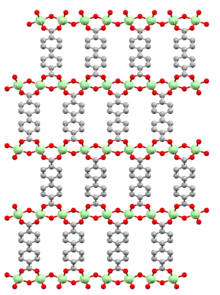DUT-5
DUT-5 (DUT steht für englisch Dresden University of Technology) ist der Name eines Materials, welches zu der Stoffklasse der Metall-organischen Gerüstverbindungen (englisch metal-organic framework, MOF) zählt. Die Gerüststruktur ist eine expandierte Version der MIL-53-Struktur und besteht aus Aluminiumionen (Al3+) als Metallzentren und Biphenyl-4,4′-dicarboxylat (BPDC) als Linkermolekülen.[1][2] In der DUT-5-Struktur werden anorganische [M-OH]-zick-zack-Ketten (sogenannte secondary building units, SBUs) durch die Biphenyl-4,4′-dicarboxylat-Linker mit vier benachbarten anorganischen Ketten verbunden, wodurch eindimensionale, rautenförmige Poren entstehen.


Bekannte Strukturanaloga
Die erste hergestellte DUT-5-Struktur wurde mit Al3+ als Metallzentrum synthetisiert.[1] Weitere Metalle mit den Oxidationszahlen +II oder +IV wurden später anstatt Al3+ verwendet um Materialien mit DUT-5-analogen Strukturen herzustellen.
| Name | Metallzentrum und
Oxidationszahl |
Jahr der
Erstveröffentlichung |
Zitation |
|---|---|---|---|
| DUT-5(Al) | Al3+ | 2009 | [1] |
| COMOC-2 | V3+/V4+, V4+ | 2013 | [3] |
| Mg(4S-PNO)(BPDC) | Mg2+ | 2018 | [4] |
| Co(4S-PNO)(BPDC) | Co2+ | 2018 | [4] |
Aufgrund des baukastenähnlichen Aufbaus von Metall-organischen Gerüstverbindungen können anstatt Biphenyl-4,4′-dicarboxylat weitere organische Moleküle als Linker verwendet werden, wenn diese Biphenyl-4,4′-dicarboxylat strukturell ähneln. Für die Entwicklung von funktionalisierten DUT-5-Materialien wurden funktionelle Biphenyl-4,4′-dicarboxylate eingesetzt, welche zusätzliche funktionelle Gruppen an den Benzolringen besitzen. Diese funktionellen Gruppen in den Poren des DUT-5-Gerüstes wurden einerseits für post-synthetische Modifizierungen[5][6][7] und andererseits für die Änderung von Adsorptionseigenschaften verwendet.[8]
| Funktioneller Linker | Metallzentrum | ||
|---|---|---|---|
| Al | V | Ga | |

2,2′-Bipyridin-5,5′-dicarboxylat |
[6]
MOF-253 |
- | [7]
COMOC-4 |

4,4'-Bibenzoic acid-2,2'-sulfon |
[9][10] | [8] | - |

2-amino-[1,1']-biphenyl-4,4'-dicarboxylat |
[10][11] | - | - |

2-ethynyl-[1,1']-biphenyl-4,4'-dicarboxylat |
[11] | - | - |

2-azido-[1,1']-biphenyl-4,4'-dicarboxylat |
[11] | - | - |

2-nitro-[1,1']-biphenyl-4,4'-dicarboxylat |
[10][11] | - | - |

2-iodo-[1,1']-biphenyl-4,4'-dicarboxylat |
[12] | - | - |
Einzelnachweise
- Irena Senkovska, Frank Hoffmann, Michael Fröba, Juergen Getzschmann, Winfried Böhlmann: New highly porous aluminium based metal-organic frameworks: Al(OH)(ndc) (ndc=2,6-naphthalene dicarboxylate) and Al(OH)(bpdc) (bpdc=4,4′-biphenyl dicarboxylate). In: Microporous and Mesoporous Materials. Band 122, Nr. 1-3, Juni 2009, S. 93–98, doi:10.1016/j.micromeso.2009.02.020.
- Franck Millange, Richard& I. Walton: MIL-53 and its Isoreticular Analogues: a Review of the Chemistry and Structure of a Prototypical Flexible Metal-Organic Framework. In: Israel Journal of Chemistry. Band 58, Nr. 9-10, Oktober 2018, S. 1019–1035, doi:10.1002/ijch.201800084.
- Ying-Ya Liu, Sarah Couck, Matthias Vandichel, Maciej Grzywa, Karen Leus: New V IV -Based Metal–Organic Framework Having Framework Flexibility and High CO 2 Adsorption Capacity. In: Inorganic Chemistry. Band 52, Nr. 1, 7. Januar 2013, ISSN 0020-1669, S. 113–120, doi:10.1021/ic301338a.
- Hannah Kunicki, Thomas W. Chamberlain, Guy J. Clarkson, Reza J. Kashtiban, Joseph E. Hooper: An expanded MIL-53-type coordination polymer with a reactive pendant ligand. In: CrystEngComm. Band 20, Nr. 31, 2018, ISSN 1466-8033, S. 4355–4358, doi:10.1039/C8CE00891D.
- Ceylan Yildiz, Ksenia Kutonova, Simon Oßwald, Alba Titze-Alonso, Johannes Bitzer: Post-synthetic Modification of DUT-5-based Metal Organic Frameworks for the Generation of Single-site Catalysts and their Application in Selective Epoxidation Reactions. In: ChemCatChem. Band 12, Nr. 4, 20. Februar 2020, ISSN 1867-3880, S. 1134–1142, doi:10.1002/cctc.201901434.
- Eric D. Bloch, David Britt, Chain Lee, Christian J. Doonan, Fernando J. Uribe-Romo: Metal Insertion in a Microporous Metal−Organic Framework Lined with 2,2′-Bipyridine. In: Journal of the American Chemical Society. Band 132, Nr. 41, 20. Oktober 2010, ISSN 0002-7863, S. 14382–14384, doi:10.1021/ja106935d.
- Ying-Ya Liu, Roel Decadt, Thomas Bogaerts, Karen Hemelsoet, Anna M. Kaczmarek: Bipyridine-Based Nanosized Metal–Organic Framework with Tunable Luminescence by a Postmodification with Eu(III): An Experimental and Theoretical Study. In: The Journal of Physical Chemistry C. Band 117, Nr. 21, 30. Mai 2013, ISSN 1932-7447, S. 11302–11310, doi:10.1021/jp402154q.
- Guangbo Wang, Karen Leus, Sarah Couck, Pieter Tack, Hannes Depauw: Enhanced gas sorption and breathing properties of the new sulfone functionalized COMOC-2 metal organic framework. In: Dalton Transactions. Band 45, Nr. 23, 2016, ISSN 1477-9226, S. 9485–9491, doi:10.1039/C6DT01355D.
- Sarah Couck, Ying-Ya Liu, Karen Leus, Gino V. Baron, Pascal Van der Voort: Gas phase adsorption of alkanes, alkenes and aromatics on the sulfone-DUT-5 Metal Organic Framework. In: Microporous and Mesoporous Materials. Band 206, April 2015, S. 217–225, doi:10.1016/j.micromeso.2014.11.028.
- Selda Halis, Nele Reimer, Arne Klinkebiel, Ulrich Lüning, Norbert Stock: Four new Al-based microporous metal-organic framework compounds with MIL-53-type structure containing functionalized extended linker molecules. In: Microporous and Mesoporous Materials. Band 216, November 2015, S. 13–19, doi:10.1016/j.micromeso.2015.01.030.
- Meike A. Gotthardt, Sylvain Grosjean, Tobias S. Brunner, Johannes Kotzel, Andreas M. Gänzler: Synthesis and post-synthetic modification of amine-, alkyne-, azide- and nitro-functionalized metal–organic frameworks based on DUT-5. In: Dalton Transactions. Band 44, Nr. 38, 2015, ISSN 1477-9226, S. 16802–16809, doi:10.1039/C5DT02276B.
- Babak Tahmouresilerd, Michael Moody, Louis Agogo, Anthony F. Cozzolino: The impact of an isoreticular expansion strategy on the performance of iodine catalysts supported in multivariate zirconium and aluminum metal–organic frameworks. In: Dalton Transactions. Band 48, Nr. 19, 2019, ISSN 1477-9226, S. 6445–6454, doi:10.1039/C9DT00368A.